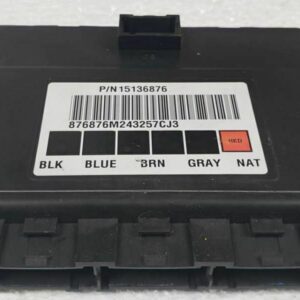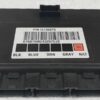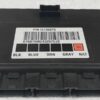Restore Your Vehicle’s Electrical System with a VIN-Programmed BCM
Are you battling a storm of bizarre electrical issues in your GM truck or van? From power windows that won’t cooperate and flickering dash lights to a security system that randomly prevents your engine from starting, these frustrating problems often trace back to a single component: a failing Body Control Module (BCM). Instead of paying for expensive diagnostic time and dealership programming fees, take control of the repair with this reliable, VIN-programmed BCM.
A Technician’s Notebook: The Case of the Haunted Silverado
I remember a 2005 Silverado 2500 that came into my shop with a list of symptoms that sounded like the truck was possessed. The radio would cut out, the dome light wouldn’t work, and worst of all, it would intermittently refuse to crank. The owner had already replaced the battery and checked the alternator to no avail. My diagnostic scan revealed a cascade of communication codes (U-codes), indicating a network failure. The problem wasn’t the individual parts; it was the BCM, the network’s traffic controller, that was failing. Installing a new, properly programmed BCM resolved every single issue, restoring the truck and the owner’s peace of mind.
This isn’t just a replacement part; it’s a direct solution. We eliminate the biggest hurdle in this repair by programming this Programmed GM BCM to your vehicle’s specific VIN before it ships. This means you get a module loaded with the latest GM software updates that’s ready for installation right out of the box, saving you a trip to the dealer and hundreds in programming fees.
Is Your GM Truck or Van Showing These Symptoms?
- ✔ Power windows, door locks, or mirrors work intermittently or not at all.
- ✔ The security or anti-theft light is illuminated, causing a no-start or crank-no-start condition.
- ✔ Gauges on the instrument cluster drop to zero, sweep erratically, or stop working.
- ✔ Interior lights, headlights, or taillights flicker, stay on, or fail to illuminate.
- ✔ The radio or climate control system functions incorrectly.
- ✔ Your scan tool shows communication error codes like U0140, U0155, or U0164.
- ✔ The horn honks unexpectedly or doesn’t work at all.
A Straightforward Guide to BCM Installation
- ✔ Safety First: Disconnect the negative terminal of your vehicle’s battery and wait at least 10 minutes to allow all systems to discharge.
- ✔ Locate the Module: On Silverado and Sierra pickups, the BCM is typically found under the driver’s side dashboard, near the steering column. For Express and Savana vans, it is usually located in the center of the dashboard.
- ✔ Disconnect and Remove: Carefully unplug the electrical connectors from the old BCM. These connectors have locking tabs that must be depressed to be removed—do not use force. Once unplugged, remove any bolts or clips securing the module and take it out.
- ✔ Install the New BCM: Mount your new, pre-programmed module in the same location and securely reconnect all electrical connectors, ensuring they click into place.
- ✔ Reconnect and Test: Reconnect the negative battery terminal. Turn the ignition key to the ‘ON’ position (without starting the engine) and verify that your power accessories, lights, and gauges are now functioning correctly.
- ✔ Final Relearn Procedures (If Required): After installation, check your instrument panel for any new warning lights. If the airbag light is on or you see messages related to the braking system, a post-install relearn procedure may be necessary as detailed below.
Important Post-Installation Information
While this BCM is programmed for a straightforward installation, some vehicle systems may require recalibration to recognize the new module. This is a normal part of the process.
- Airbag System Sync: If the airbag warning light is on after installation, a procedure called ‘Setup SDM Primary Key in BCM’ is needed. This syncs the new BCM with the airbag system and must be performed with a professional-grade diagnostic tool.
- Brake Pedal Position Relearn: On some models, a brake pedal position sensor recalibration might be required to ensure proper brake light operation and to satisfy the traction control system.
- No Core Charge: You can keep your old part. We do not require you to send the original module back, simplifying your repair process.
Disclaimer: Specific procedures can vary by vehicle model and options. Always consult a factory service manual or a qualified technician for guidance specific to your vehicle.
Verified Vehicle Compatibility
This module is a direct replacement for part numbers 15167329, 15194169, 15747545, 15136224, 15116065, 15198115, 15136876, and 10367689, and fits the following models (excluding Crew Cab unless specified):
- Chevrolet Silverado 1500/2500/3500: 2003-2006 & 2007 Classic
- GMC Sierra 1500/2500/3500: 2003-2006 & 2007 Classic
- Chevrolet Express 1500/2500/3500 Van: 2003-2007
- GMC Savana 1500/2500/3500 Van: 2003-2007
- Chevrolet SSR: 2003-2006
Frequently Asked Questions
Do I absolutely have to provide my VIN?
Yes. Providing your 17-digit Vehicle Identification Number (VIN) is essential. We use it to load the correct, vehicle-specific software and updates from GM, ensuring the BCM functions perfectly with the options your vehicle was built with.
What kind of tool is needed for the post-install relearns?
The Airbag System Sync and Brake Pedal Position relearn require a bi-directional diagnostic scan tool. These are professional-grade tools that can send commands to the vehicle’s modules, which is something a basic code reader cannot do.
Is this a repair I can do myself?
For many DIY enthusiasts, yes. The physical replacement of the module is typically straightforward, involving basic hand tools. The key is being aware that a relearn procedure might be the final step, which may require a visit to a shop if you don’t own a high-level scan tool.
Will this fix my ‘Service 4WD’ message?
While a failing BCM can cause a variety of issues, the ‘Service 4WD’ message is more commonly associated with the Transfer Case Control Module (TCCM) or the encoder motor. It’s important to diagnose the specific codes before ordering parts.
Why is there no core charge?
We aim to make your repair as simple and cost-effective as possible. By not requiring a core return, we save you the time, hassle, and expense of shipping your old part back to us.



